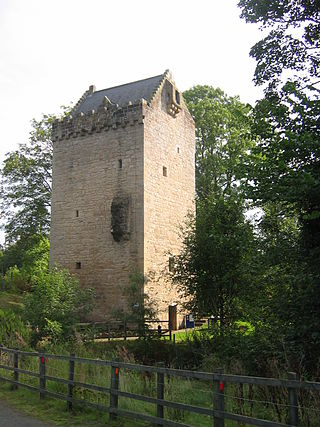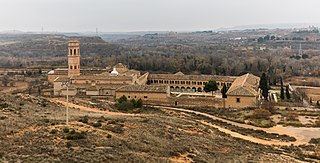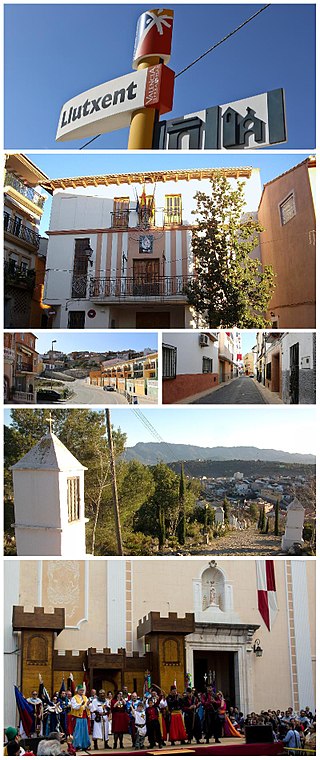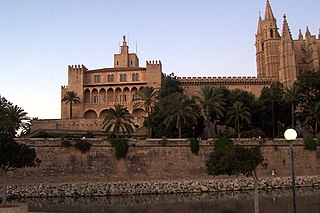
A castle is a type of fortified structure built during the Middle Ages predominantly by the nobility or royalty and by military orders. Scholars usually consider a castle to be the private fortified residence of a lord or noble. This is distinct from a mansion, palace and villa, whose main purpose was exclusively for pleasance and are not primarily fortresses but may be fortified. Use of the term has varied over time and, sometimes, has also been applied to structures such as hill forts and 19th- and 20th-century homes built to resemble castles. Over the Middle Ages, when genuine castles were built, they took on a great many forms with many different features, although some, such as curtain walls, arrowslits, and portcullises, were commonplace.

Leeds Castle is a castle in Kent, England, 7 miles (11 km) southeast of Maidstone. It is built on islands in a lake formed by the River Len to the east of the village of Leeds. It is a historic Grade I listed estate.

Castles have played an important military, economic and social role in Great Britain and Ireland since their introduction following the Norman invasion of England in 1066. Although a small number of castles had been built in England in the 1050s, the Normans began to build motte and bailey and ringwork castles in large numbers to control their newly occupied territories in England and the Welsh Marches. During the 12th century the Normans began to build more castles in stone – with characteristic square keep – that played both military and political roles. Royal castles were used to control key towns and the economically important forests, while baronial castles were used by the Norman lords to control their widespread estates. David I invited Anglo-Norman lords into Scotland in the early 12th century to help him colonise and control areas of his kingdom such as Galloway; the new lords brought castle technologies with them and wooden castles began to be established over the south of the kingdom. Following the Norman invasion of Ireland in the 1170s, under Henry II, castles were established there too.

Soria is a municipality and a Spanish city, located on the Douro river in the east of the autonomous community of Castile and León and capital of the province of Soria. Its population is 38,881, 43.7% of the provincial population. The municipality has a surface area of 271,77 km2, with a density of 144.97 inhabitants/km2. Situated at about 1065 metres above sea level, Soria is the second highest provincial capital in Spain.

A keep is a type of fortified tower built within castles during the Middle Ages by European nobility. Scholars have debated the scope of the word keep, but usually consider it to refer to large towers in castles that were fortified residences, used as a refuge of last resort should the rest of the castle fall to an adversary. The first keeps were made of timber and formed a key part of the motte-and-bailey castles that emerged in Normandy and Anjou during the 10th century; the design spread to England, Portugal, south Italy and Sicily. As a result of the Norman invasion of 1066, use spread into Wales during the second half of the 11th century and into Ireland in the 1170s. The Anglo-Normans and French rulers began to build stone keeps during the 10th and 11th centuries, including Norman keeps, with a square or rectangular design, and circular shell keeps. Stone keeps carried considerable political as well as military importance and could take a decade or more to build.

A tower house is a particular type of stone structure, built for defensive purposes as well as habitation. Tower houses began to appear in the Middle Ages, especially in mountainous or limited access areas, to command and defend strategic points with reduced forces. At the same time, they were also used as an aristocrat's residence, around which a castle town was often constructed.

Rueda Abbey or Rueda de Ebro Abbey is a former Cistercian monastery in Sástago in the Ribera Baja del Ebro comarca, province of Zaragoza, Aragon, Spain, 74 kilometres to the south-east of Zaragoza on the left bank of the Ebro. The buildings have been preserved by the government and are intended to be used for a hotel and conference centre.

Castellgalí is a municipality in the south of the region of Bages, Catalonia, where the Cardener and Llobregat rivers meet, and contains the BCIN Boades archaeological site and the Torre del Breny, one of the most outstanding ancient Greek sites in Catalonia.

Peracense is a town in the province of Teruel, Aragon, on the north-east of Spain. It is located 51 kilometres from Teruel, the capital province.

Barryscourt Castle is a castle located in eastern County Cork in southern Ireland, close to the town of Carrigtwohill.

Quinto is a town and municipality in the province of Zaragoza, northeast Spain. It is located on the south bank of the river Ebro about 41 km south-east of Zaragoza, capital city of Aragon. In 2017 its population was 1,960, with an area of 118.40 km². Quinto is the capital of the comarca (county) of Ribera Baja del Ebro.

Llutxent is a town located in the eastern part of Spain, in the Valencian Community, within the county of the Vall d'Albaida, 80 km south of Valencia and 110 km north of Alicante. As of 2016, it is inhabited by 2,402 people.

Sos del Rey Católico is a historic town and municipality in the Cinco Villas comarca, province of Zaragoza, in Aragon, Spain.

The Royal Palace of La Almudaina is one of the official residences of the Spanish royal family. Categorized as an Alcázar, it is located in Palma, the capital city of the Island of Mallorca, Spain.

Tarazona Cathedral is a Roman Catholic church located in Tarazona, Zaragoza province, in Aragon, Spain. The cathedral's architecture is representative of the Gothic and Mudéjar style, and is one of the few remaining examples of this type of architecture, along with Teruel Cathedral.

The Château Royal de Collioure is a massive French royal castle in the town of Collioure, a few kilometers north of the Spanish border in the French département of Pyrénées-Orientales.

The Castle of La Mota or Castillo de La Mota is a medieval fortress in the town of Medina del Campo, province of Valladolid, Spain. It is so named because of its location on an elevated hill, a mota, from where it dominates the town and surrounding land. The adjacent town came to be surrounded by an expanding series of walls in subsequent years, of which little remains.

Requesens Castle is a historical building in the municipality of Cantallops, Catalonia, Spain.

The Château de Saint-Ferriol is a late medieval - early Renaissance castle, in the village and commune of Saint-Ferriol, in the Aude département in southern France. It is situated on a ridge, overlooking valleys to the north and south, in the heart of the village of St-Ferriol, near the towns of Quillan and Esperaza.

Château de Beurthé or Château de Steinbach is a castle situated in Steinbach, municipality of Gouvy, southeastern Belgium. Its park borders on the small river Steinbach, a tributary of the Ourthe Orientale.




















